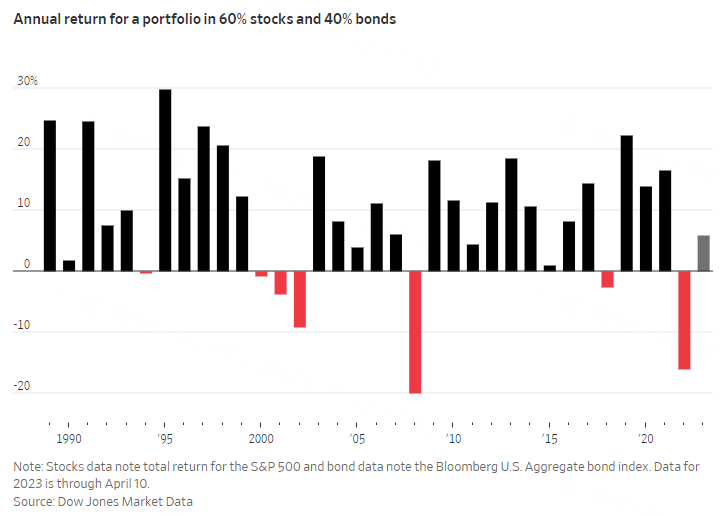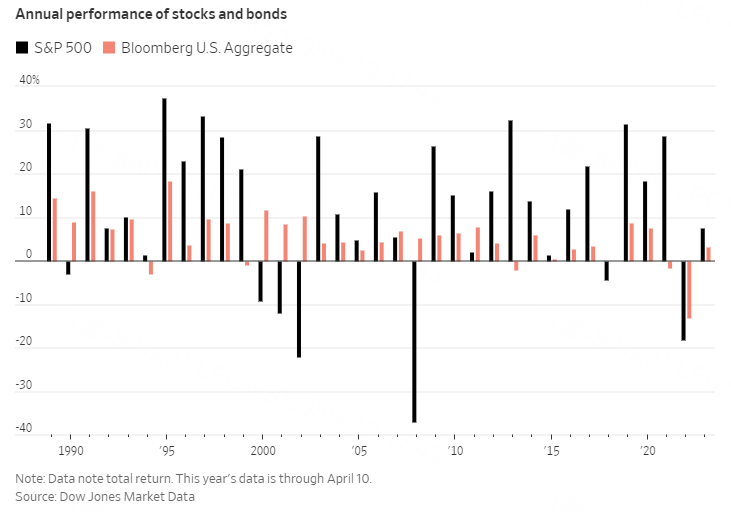The classic 60-40 investment strategy is working again after a disastrous 2022.
Americans planning for retirement have been advised for decades to diversify their holdings between stocks and bonds. It was a dependable way of investing that worked for millions of people.
Last year's tandem declines in stocks and bonds blindsided many of the strategy's followers who were counting on bonds to help cushion their portfolios when equities had a bad year.
The Federal Reserve's aggressive bid to raise interest rates to tame inflation rattled everything from stocks and bonds to oil and bitcoin. Yet by the end of last year, the clouds began to part. Stocks rallied alongside bonds, boosted by hopes that the Fed was nearing an end to its tightening campaign.
A portfolio with 60% of its money invested in U.S. stocks and 40% in the Bloomberg U.S. Aggregate bond index has gained 5.9% in 2023 as of Monday, according to Dow Jones Market Data, building on a 5.3% advance in the fourth quarter. Last year, the portfolio fell 16%, its worst year since 2008.
The recovery has emboldened individual investors who didn't stray from the 60-40 investment mix during last year's turmoil.
Scott Owen, a 74-year-old retiree living in Ponte Vedra, Fla., said he briefly considered paring his stock exposure last year but ultimately opted not to. The former mechanical engineer sold shares at a loss during the 2008 financial crisis and missed out on the market's rebound by waiting more than two years on the sidelines. He didn't want to repeat the mistake.
"That probably cost me a lot of money," Mr. Owen said. "At that time, I panicked -- I didn't know where the market was going."
For decades, investors have relied on the 60-40 investment mix to generate stable returns, earning an average 9.3% annually through the end of 2022, according to DJMD, which reviewed data going back 35 years. An investor who put $10,000 in a 60-40 portfolio in 1988 would have a principal worth more than $180,000 now, after accounting for an annual rebalance.
Behind 60-40's success? The S&P 500 tends to rebound after steep declines and investors who buy the dip are often richly rewarded. The benchmark stock index has gained 7.5% this year, including dividends, and bonds have clawed back some of their value.
Bonds helped offset some of the pain of the previous market crises, including the bursting of the dot-com bubble in 2000, the global financial crisis of 2008 and the short-lived market panic brought by the onset of the Covid-19 pandemic.
That didn't happen in 2022. An index that largely holds U.S. Treasurys, highly rated corporate bonds and mortgage-backed securities fell 13%, posting its worst year on record, while the S&P 500 declined 18%.
Individual investors close to retirement were the hardest hit because their portfolios didn't have time to recover from the losses.
Mark Teister, a 66-year-old retiree in Glenview, Ill., says he switched to a more conservative investment approach from a traditional 60-40 strategy in late 2021. He bought funds holding dividend-paying companies and value stocks, along with securities that mitigate the risk of higher bond yields. If the market stabilizes, he hopes to revert to the 60-40 mix.
"I've got to have something that protects me from doing something stupid, " said Mr. Teister, who used to work as an executive at a coffee company.
Of course, there is no guarantee that the 60-40 strategy will keep working, and the market's trajectory is especially difficult to predict. The economy is still humming along, inflation remains hot and the banking crisis that erupted in March appears to be contained -- all of which could propel the Fed to keep raising rates.
Plus, stocks remain expensive historically, and strategists warn that valuations will likely be crunched in the event of a recession. The S&P 500 is trading at 18.2 times its expected earnings over the next 12 months, down from 21.6 at the start of 2022 but above the 10-year average of 17.5.
Investors have pared their stock exposure in light of the recent tumult in markets.
Goldman Sachs expects households to be net sellers of $750 billion of equities this year, with investors instead piling into yield-bearing assets such as money-market funds and bonds. That is a stark contrast from the start of 2020 through mid-2022, when they were net buyers of $1.7 trillion in equities. Households own almost 40% of the total U.S. equity market, making them important drivers of financial markets.
Meanwhile, a March survey from the American Association of Individual Investors found that investors have increased their bond exposure to the highest level since 2021, while their stock exposure has ticked down but remains above historical averages. The respondents had about 65% of their portfolios in stocks, 15% in bonds and 20% in cash.
Still, Todd Schlanger, a senior investment strategist at Vanguard, said he expects the 60-40 strategy to work well for the next decade, pointing to lower stock valuations and attractive bond yields. Mr. Schlanger forecasts the annualized 10-year median return for a globally diversified 60-40 strategy at 5.4%.
"60-40 is used as a bellwether," Mr. Schlanger said. "That strategy we believe is an enduring one."
Leslie Hollon, 68, retired in 2022 as a pastor in San Antonio. His 60-40-style portfolio fell about 15% last year, prompting him to withdraw less money to put toward his living expenses. Despite the declines, Dr. Hollon said he is confident in his investing approach and expects bonds to make a comeback this year.
"It was encouraging that there's resilience in 60-40, and the resiliency was showing in still a very tumultuous market," said Mr. Hollon, who hopes to continue using his retirement funds to travel with his wife.


